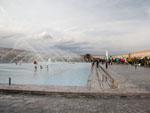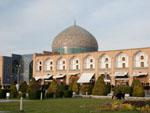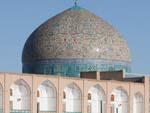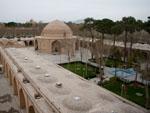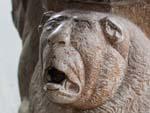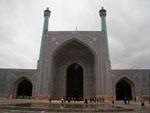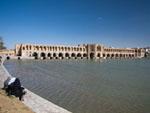The city of Esfahan (or Isfahan) is known as being one of the jewels of Iran and all the films and documentaries of Iran we had watched portrayed the historically rich city with such romantic notions. One of the famous Persian proverbs describes Esfahan as ‘half of the world’, as it once dominated as one of the world’s largest cities famous for its mosques, palaces, bridges and the beautiful Imam Square (Naqsh-e Jahan Square).
We arrived in Esfahan on a comfortable bus ride from Yazd and checked into the Amir Kabir Hotel in the evening. The trip took about four-and-a- half hours, and was about 100,000 Tumans (equivalent to five dollars) for both of us. We even received a snack box with a wide assortment of biscuits and juice (which we later found to be a standard part of any Iranian bus ride).
thydzikgooglemap(http://sonyaandtravis.com/maps/iran-yazd-to-esfahan.xml)
Naqsh-e Jahan Square (Imam Square)
Our first morning in Esfahan was spent familiarising ourselves with Imam Square. The Square was about a fifteen minute walk from our hotel. As it was Friday, we weren’t able to enter the main mosque – Imam Mosque as preparations for Friday prayers were taking place. We wandered around the square admiring its grandness (in size it is 160 by 508 meters and second biggest in the world after to Tiananmen Square in China). The perimeter surrounding the square is an under covered bazaar selling various Persian delights from gaz (the local Isfahahni speciality, a nougat-like sweet), rugs, handicraft to jewels made of Iranian turquoise.
thydzikgooglemap(http://sonyaandtravis.com/maps/esfahan-iran-imam-square.xml,s)
The highlights of our exploration of Imam Square were:
Sheikh Lotfollah Mosque – located on the eastern side of imam Square this is a beautiful, perfectly architectured mosque built during reign of Shah Abbas I. We stood in the prayer hall dome of the mosque in absolute awe of its brilliant mosaic designs and architecture and found that no photos can do it justice.
Ali Qapu Palace – on the western side opposite to Sheikh Lotfollah Mosque is the Ali Qapu Palace. It was the entertainment palace for Shah Abbas the Great during the Safavid period and also a gateway to other palaces beyond the Square. The palace must have been quite impressive with its colourful motifs, however much of it is now damaged. The terrace provided great views of Imam Square.
Chehel Sotun Palace – we wandered across to this palace which is outside the Square. It started raining a little, however the site was still bustling with activity. It was still Noruz holidays, and everywhere we had been in Esfahan was unimaginably busy. The Palace is impressive (as with everything we’d seen so far!), but most enjoyable were the beautiful frescoes in the music room. Some depict battles between the Uzbeks and India… others show lavish banquets where the Shah entertained his guests.
Imam Mosque – Also known as Shah Mosque, this is one of the famous Isfahani icons (it’s even featured on the Iranian 20,000 Rials banknote). As you first walk into Imam Square it is impossible not to notice the beautiful iwan (entrance) to the mosque, the arch of the iwan decorated with blue stalactite tiles. The main courtyard also does not disappoint as each of the iwans to the prayer halls are truly breathtaking in their size, colour and mosaic designs.
We had lunch at a traditional Iranian restaurant in the square where we had some of the local Iranian cuisine – Dizi. This dish is particularly interesting as it comes in what looks like a handle-less clay pot with a pestle. It is served by draining the soup into a separate bowl and then mashing the contents of the pot (some kind of vegetable/meat stew) ferociously. You then place bite sized pieces of bread into the soup and eat the soup soaked bread, along with the solid remnants of the stew. It was actually quite tasty!
That evening we explored the surrounding bazaars in search of a carpet!
Jameh Mosque
Morning of the second day was spent wandering through the bazaars (again!). We then headed to the post office (which turned out to be closed due to Noruz), and then Jameh Mosque. This mosque is still operating and so we explored quietly. It is set on 20,000 square metres and is one of the biggest mosques in Iran.
Bridges of Zayandeh River
We then walked to the Zayandeh River. It was a Saturday afternoon and the local Isfanhani as well as other local Iranian tourists were enjoying picnicking along the river with their extended families (we’d noticed Iranian’s loved picnicking!). We were there to look at the beautiful and famous covered bridges. We started at Si-o-Seh Bridge which contains thirty-three arches and walked all the way to Khaju Bridge (famous for its two-tiers of arches), passing by Chubi bridge along the way. In total, the bridge walk would have been about five kilometres in total and took a good hour!
Chahar Bagh Madreseh
For the rest of the afternoon we visited Madraseh Ye Chahar Bagh, the Theological School of the Shah’s Mother. Usually closed, but opened for Noruz festivities, it is a pretty complex with a lovely courtyard filled with trees.
Hasht Behesht Palace
After we visited the Hasht Behesht Palace, which was once again another great palace but now very badly damaged.
Our last evening in Esfahan was spent enjoying some gaz, falude (rice flour sorbet with rose water) and strawberries in our own little picnic at Imam Square and doing some more people watching and bazaar-wandering!
thydzikgooglemap(http://sonyaandtravis.com/maps/esfahan-iran.xml)





































































































